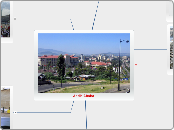Addis Ababa
Addis Ababa was formed in 1878. It is the capital city of Ethiopia and the African Union and its predecessor, the OAU. It is also the largest city in Ethiopia. With a population of 2,738,248 according to the 2007 population census. Addis Ababa is competing with Kabul to be the world's largest city in a landlocked country. As a chartered city, Addis Ababa has the status of both a city and a state. It is often called the capital of Africa or the "African Capital" due to its historical, diplomatic and political significance for the continent.
Source: http://en.wikipedia.org/wiki/Addis_Ababa
Urban air pollution
The workshop on “Promotion of Clean Fuels
and Vehicles in Ethiopia” was spearheaded by a national
PCFV affiliate, the Forum for Environment (FfE) working
in partnership with the Ethiopian Petroleum Enterprise
(EPE), the Ministry of Transport and Communication
(MoT&C), the Federal and the Addis Ababa Environment
Protection Authority (FEPA and AAEPA), and Environment
and Development/Ethiopia (ENDA-Ethiopia). It was held
on 22 July 2008 in Ghion Hotel. The workshop had two
principal objectives, namely to sensitize stakeholders on
the health and environmental benefits of lowering sulphur
levels in fuels and adopting cleaner vehicles and cleaner
vehicle technologies to reduce urban air pollution, and to
urge Ethiopia to import lower sulphur diesel fuels (at least
500ppm).
Source: http://www.unep.org/pcfv/pdf/AddisAbabaHighlightsVol5No8.pdf
What if the air quality pilot study project that is aimed to measure the levels of pollutants such as particulate matter, lead, sulfur dioxide, ozone, carbon monoxide and other hazardous toxins that have yet to be quantified is successful with the funding being provided generously? It could not only lead to longer-term air quality monitoring programs but also help the Ethiopian EPA better understand the links between air pollution and health problems while laying the groundwork for setting and enforcing air quality standards in Addis Ababa, which is home to about 3 million people.
Urban governance
The city of Addis Ababa and its citizens were experiencing poor urban governance as manifested in a highly centralised government system, un-participatory governance, poor service delivery, and lack of transparency. The political system was heavily bureaucratic involving a four-layered decision- making structure with most of the real power concentrated at city level. In particular, the lowest administrative structures, the Kebele Administrations, were almost solely preoccupied with routine administrative tasks. They were not involved in urban development and good governance endeavours in any meaningful way. A highly centralised political system also meant that active community participation in the socio-economic and political affairs of their neighbourhood was undermined. Delivery of municipal and public services was often inefficient and non-transparent, while levels of corruption were high in some areas.
Source:
http://www.worldmayor.com/manifestos05/addis_ababa_05.html
What if the nation improves the overall urban governance of Addis Ababa by reforming these four policies: decentralisation, community participation, civil service reform and improvement of service delivery.
Main topic
Waste and Sewage Problems
Addis Ababa has an extremely limited sewage system. It was originally designed for approximately 200,000 residents but budget constraints and management problems allow the sewage system to serve only 6,000 households in the city. Of an estimated 1386 cubic meters of waste generated each day in the city, only 750 cubic meters are collected or accounted for by the city sewage system. According to a study by Meson (1996), solid waste and sewage are ranked as the top environmental problems in Addis Ababa, ahead of population congestion.
Concern about the urgency of the waste problems in the city has been growing steadily in the last years, though several measures for promoting recycling and proper waste management are still needed for the city to even begin solving the problem. With more secure municipal funds, the city can integrate an expanded sewage system that may more adequately address the needs of the city.
Source: http://www.globenet.org/preceup/pages/ang/chapitre/capitali/transver/ethiopie.htm
What if
What if the municipal budget was able to maintain secure funds and a stable budget to bolster the construction of a new sewage system for the growing population?
The city would be able to more adequately house its population, solving pollution problems and improving sanitary conditions. Addis Ababa prides itself on being a city with potential, but only when it improves its waste management system can it truly become a better city. Though often overlooked, waste management is one of main problems any urban area faces and deals with.
Inadequate in social services
Addis Ababa is characterised by its spontaneous growth as an indigenous city with very little impact of external forces. The city began to develop as a political, economic and cultural centre in subsequent years. Services such as piped water, electric light and other facilities attracted migrant population from other parts of the country. In addition to this rate of rural-urban migration drained rural labour force from agricultural production created problems of unemployment, congestion and strains on existing inadequate social services in Addis Ababa (Solomon Gebre, 1996)
Source: http://www.globenet.org/preceup/pages/ang/chapitre/capitali/transver/ethiopie.htm
"What if"
What if the government allowed for more funding for social services such as piped water, electric light and other facilities to compensate for the influx of increased migration. Unemployment would become less of a problem as more workers are compensated for. The strains and congestion on the existing inadequate social services would also be diminished if the government were to add additional funding for these services.
Housing for poor
Addis Ababa is no paradise for most of its residents and workers. The majority of the population lives in substandard housing and many citizens lack running water or electricity.
The existing housing shortage, which is the main problem of the city, is created as a
result of rapid population growth rate and insufficient housing supply to satisfy the
newly formed households. The units, built with mud and wood, are in poor physical condition and in need of complete demolishment and replacement.
Sources: http://www.macalester.edu/courses/geog61/kshively/intro.html, http://www.hdm.lth.se/fileadmin/hdm/alumni/papers/sdd2006/sdd2006-12.pdf









